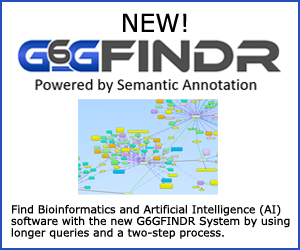MetAssimulo
Category Metabolomics/Metabonomics>Metabolic Profiling/Analysis Systems/Tools
Abstract MetAssimulo is a MATLAB-based package that has been developed to simulate Hydrogen-1 Nuclear Magnetic Resonance (1H-NMR) spectra of complex mixtures such as metabolic profiles.
Drawing data from a metabolite standard spectral database in conjunction with concentration information input by the user or constructed automatically from the Human Metabolome Database; MetAssimulo is able to create realistic metabolic profiles containing large numbers of metabolites with a range of user-defined properties.
Current features include the simulation of two (2) groups (‘case’ and ‘control’) specified by means and standard deviations of concentrations for each metabolite.
The software enables addition of spectral noise with a realistic autocorrelation structure at user controllable levels.
A crucial feature of the algorithm is its ability to simulate both intra- and inter-metabolite correlations, the analysis of which is fundamental to many techniques in the field.
Further, MetAssimulo is able to simulate shifts in NMR peak positions that result from matrix effects such as pH differences which are often observed in metabolic NMR spectra and pose serious challenges for statistical algorithms.
MetAssimulo Implementation --
MetAssimulo performs various functions accessed though the Graphical User Interface (GUI): pre-processing the pure spectra, simulating metabolite concentrations, incorporating peak shifts and creating the final mixture spectrum.
By default it produces two (2) groups of spectra based on different metabolite mixtures; these could represent controls (normal) and cases (diseased) subjects.
In real NMR spectra, the signal intensity is affected by the extent to which the observed nuclei are allowed to relax before each observation.
In MetAssimulo, the manufacturer does Not currently attempt to simulate the effects of differential inter-molecular relaxation.
However, intra-molecular relaxation effects are accounted for by the fact that experimentally obtained pure compound spectra are used to form the mixture spectra.
MetAssimulo Setting Parameters --
Parameters can be altered either in the MetAssimulo GUI or within the parameter file ‘parameters.txt’. The interface provides the user with several different processing options.
For example the second group (‘cases’) may be specified as fold change ratios of the concentrations of the first group and the user can specify whether to produce output with or without peak shifts or both.
The user also chooses whether to include inter-metabolite correlation (pairwise correlations between metabolites) or Not; either as a text file whose entries can be altered using the interface or constructed from scratch in the Correlation GUI.
MetAssimulo Input Files -
The Human Metabolome Database (HMDB), contains information about more than 7,900 metabolites found in humans and includes literature data relating to normal and abnormal concentrations in biofluids.
Metabocards is the flat file download of the entire database, available at HMDB. Also required is the HMDB set of NMR Peak Lists (containing locations of individual peaks for metabolites) which is available in a downloadable zip-file.
There are a number of additional input files that are required for MetAssimulo:
1) Concentration files (see Note1) are needed for ‘both groups’ of metabolites, these detail the mean and standard deviation of the concentration for each metabolite.
2) An NMR Standard Spectral Database (NSSD) comprising standard 1D 1H-NMR spectra for metabolites is essential.
MetAssimulo is designed to work with any metabolite database set out in the Bruker file format.
Standard spectra of forty-eight (48) of the most abundant metabolites in normal human urine, is distributed with MetAssimulo.
3) An Experiment file identifying the experiments to use in the metabolite database, as one metabolite may have many spectra, taken at different pH for example.
4) Proton file listing the number of protons, pk observed for each metabolite, k.
5) Multiplet data files (see Note1) specifying the position of each peak in a multiplet for each metabolite in order to incorporate simulated peak shifts. Known pKa values and acid/base limits can also be included.
6) Inter-metabolite correlations can be input via a text file or the GUI.
7) Synonym files (see Note1) that allow MetAssimulo to match metabolites in the HMDB data to those in the NSSD.
8) A Parameter file, containing the default values or simulation parameters (alterable in the GUI).
Note1: Can be generated automatically using ‘Format HMDB Data’ within MetAssimulo.
MetAssimulo Examples of all input files -
Examples of all input files in the appropriate format are included with the MetAssimulo distribution. Much of the required input data can be generated using the built-in function ‘Format HMDB Data’ (accessed via the GUI).
‘Format HMDB Data’ produces the files necessary for conversion between the local database and HMDB synonyms, data required for peak shift simulation and a raw template of concentration data for ‘normal’ urine.
The normal urine concentration file provided with the distribution has been optimized to provide realistic values and correct a number of errors found in the current version of the HMDB while reducing the number of metabolites used in order to decrease processing time.
MetAssimulo Documentation and additional info --
Extensive documentation is provided and for additional info, see the following paper:
Muncey et al.: MetAssimulo:Simulation of Realistic NMR Metabolic Profiles. BMC Bioinformatics 2010 11:496.
System Requirements
Contact manufacturer.
Manufacturer
- Department of Epidemiology and Biostatistics
- School of Public Health
- Imperial College London, and
- Biomolecular Medicine
- Department of Surgery and Cancer
- Imperial College London, UK
Manufacturer Web Site MetAssimulo
Price Contact manufacturer.
G6G Abstract Number 20688
G6G Manufacturer Number 104318







